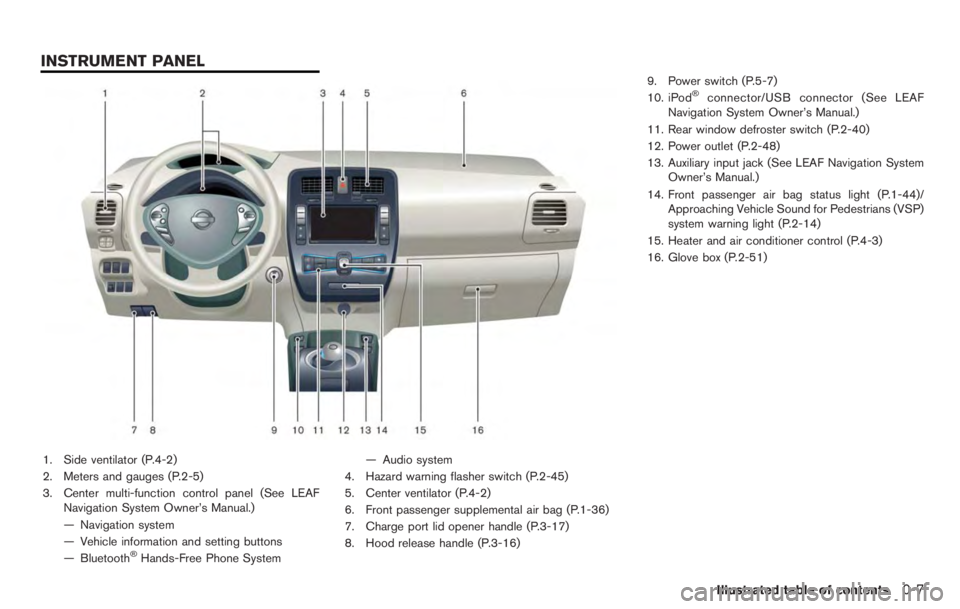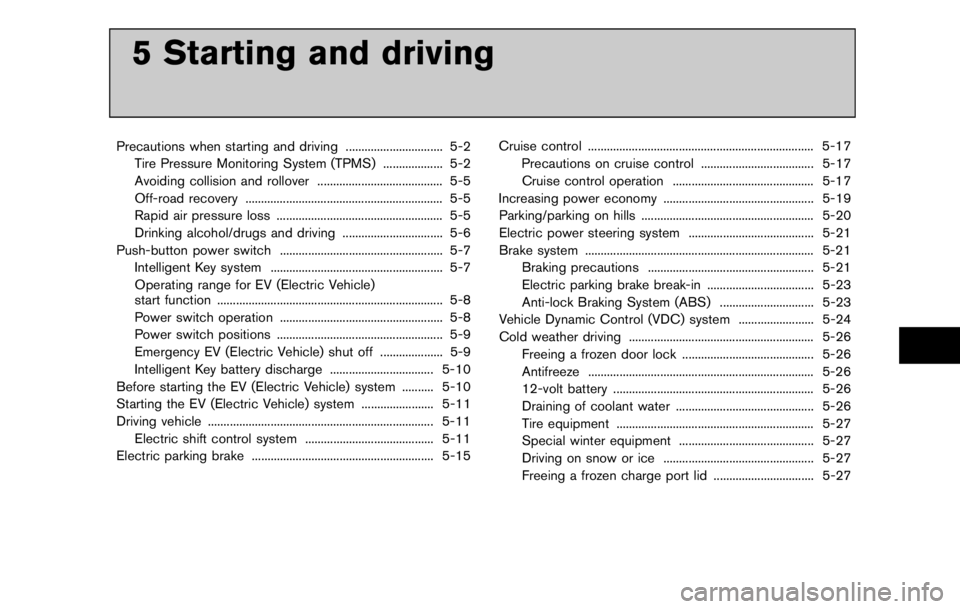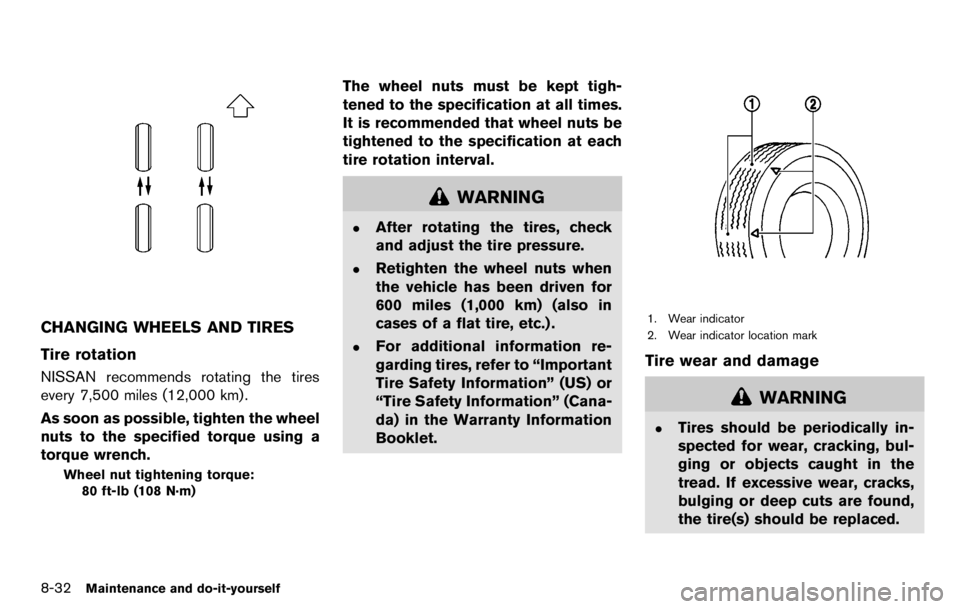2012 NISSAN LEAF ESP
[x] Cancel search: ESPPage 18 of 1062

.Do not place metalized film or any
metal parts (antenna, etc.) on the
windows. This may cause poor re-
ception of the signals from the tire
pressure sensors, and the TPMS will
not function properly.
Some devices and transmitters may temporarily
interfere with the operation of the TPMS and
cause the low tire pressure warning light to
illuminate. Some examples are:
. Facilities or electric devices using similar
radio frequencies that are near the vehicle.
. If a transmitter set to similar frequencies is
being used in or near the vehicle.
. If a computer (or similar equipment) or a DC/
AC converter is being used in or near the
vehicle.
FCC Notice:
For USA:
This device complies with Part 15 of the
FCC Rules. Operation is subject to the
following two conditions: (1) This device
may not cause harmful interference, and
(2) this device must accept any interfer-
ence received, including interference that
may cause undesired operation. NOTE:
Changes or modifications not expressly
approved by the party responsible for
compliance could void the user’s authority
to operate the equipment.
For Canada:
This device complies with RSS-210 of
Industry Canada. Operation is subject to
the following two conditions: (1) this
device may not cause interference, and
(2) this device must accept any interfer-
ence, including interference that may
cause undesired operation of the device.
TPMS with Easy Fill Tire Alert
When tire pressure is low, the low tire pressure
warning light illuminates.
This vehicle provides visual and audible signals
to help you inflate the tires to the recommended
COLD tire pressure.
Vehicle set-up:
1. Park the vehicle in a safe and level place.
2. Apply the parking brake and push the P
position switch on the selector lever.
3. Place the power switch in the ON position. Do not place in the READY to drive mode. Operation:
1. Add air to the tire.
2. After a few seconds, the hazard indicators
will start flashing.
3. When the designated pressure is reached, the horn beeps once and the hazard
indicators stop flashing.
4. Perform the above steps for each tire.
. If the tire is over-inflated more than approxi-
mately 4 psi (30 kPa), the horn beeps and
the hazard indicators flash 3 times. To
correct the pressure, push the core of the
valve stem on the tire briefly to release
pressure. When the pressure reaches the
designated pressure, the horn beeps once.
. If the hazard indicator does not flash within
approximately 15 seconds after starting to
inflate the tire, it indicates that the Easy Fill
Tire Alert is not operating.
. The TPMS will not activate the Easy Fill Tire
Alert under the following conditions:
— If there is interference from an external
device or transmitter.
— The air pressure from the inflation device is not sufficient to inflate the tire such as
those using a power socket.
Page 20 of 1062

inflated tires.
Rapid air pressure loss can affect the handling
and stability of the vehicle, especially at highway
speeds.
Help prevent rapid air pressure loss by main-
taining the correct air pressure and visually
inspect the tires for wear and damage. See
“Wheels and tires” in the “8. Maintenance and
do-it-yourself” section of this manual.
If a tire rapidly loses air pressure or “blows-out”
while driving maintain control of the vehicle by
following the procedure below. Please note that
this procedure is only a general guide. The
vehicle must be driven as appropriate based on
the conditions of the vehicle, road and traffic.
Page 236 of 1062

WARNING
In case of a collision:
.If your vehicle is drivable, pull your
vehicle off the road, push the P
(Park) position switch on the selec-
tor lever, apply the parking brake
and turn the EV (Electric Vehicle)
system off.
. Check your vehicle to see if there
are exposed high-voltage parts or
cables. For their locations, see
“High-voltage components” earlier
in this section. To avoid personal
injury, never touch high-voltage wir-
ing, connectors, and other high-
voltage parts, such as inverter unit
and Li-ion battery. An electric shock
may occur if exposed electric wires
are visible when viewed from inside
or outside of your vehicle. There-
fore, never touch exposed electric
wires.
. If the vehicle receives a strong
impact to the floor while driving,
stop the vehicle in a safe location
and check the floor. .
Leaks or damage to the Li-ion
battery may result in a fire. If you
discover them, contact emergency
services immediately. Since the
fluid leak may be lithium manga-
nate from the Li-ion battery, never
touch the fluid leak inside or out-
side the vehicle. If the fluid contacts
your skin or eyes, wash it off
immediately with a large amount of
water and receive immediate medi-
cal attention to help avoid serious
injury.
. If a fire occurs in the EV (Electric
Vehicle) , leave the vehicle as soon
as possible. Only use a type ABC,
BC or C fire extinguisher that is
meant for use on electrical fires.
Using a small amount of water or
the incorrect fire extinguisher can
result in serious injury or death from
electrical shock.
. If your vehicle needs to be towed,
do it with the front wheels raised. If
the front wheels are on the ground
when towing, the traction motor
may generate electricity. This may
damage the components of the EV
(Electric Vehicle) system and cause a fire.
. If you are not able to safely assess
the vehicle due to vehicle damage,
do not touch the vehicle. Leave the
vehicle and contact emergency ser-
vices. Advise 1st responders that
this is an electric vehicle.
. In the event of an accident that
requires body repair and painting,
the vehicle should be delivered to a
NISSAN certified LEAF dealer to
have the Li-ion battery pack and
high voltage parts such as the
inverter, including the wiring har-
ness, removed prior to painting. Li-
ion battery packs exposed to heat in
the paint booth will experience
capacity loss. Damaged Li-ion bat-
tery packs may also pose safety
risks to untrained mechanics and
repair personnel.
ROAD ACCIDENT PRECAUTIONS
Page 321 of 1062

.The seat belts, the side air bags and
curtain air bags are most effective
when you are sitting well back and
upright in the seat. The side air bag
and curtain air bag inflate with great
force. Do not allow anyone to place
their hand, leg or face near the side
air bag on the side of the seatback
of the front seat or near the side
roof rails. Do not allow anyone
sitting in the front seats or rear
outboard seats to extend their hand
out of the window or lean against
the door. Some examples of dan-
gerous riding positions are shown
in the previous illustrations.
. When sitting in the rear seat, do not
hold onto the seatback of the front
seat. If the side air bag inflates, you
may be seriously injured. Be espe-
cially careful with children, who
should always be properly re-
strained. Some examples of danger-
ous riding positions are shown in
the illustrations.
. Do not use seat covers on the front
seatbacks. They may interfere with
side air bag inflation.
Safety—Seats, seat belts and supplemental restraint system1-41
Page 374 of 1062

.Do not place metalized film or any
metal parts (antenna, etc.) on the
windows. This may cause poor re-
ception of the signals from the tire
pressure sensors, and the TPMS will
not function properly.
Some devices and transmitters may temporarily
interfere with the operation of the TPMS and
cause the low tire pressure warning light to
illuminate. Some examples are:
. Facilities or electric devices using similar
radio frequencies that are near the vehicle.
. If a transmitter set to similar frequencies is
being used in or near the vehicle.
. If a computer (or similar equipment) or a DC/
AC converter is being used in or near the
vehicle.
FCC Notice:
For USA:
This device complies with Part 15 of the
FCC Rules. Operation is subject to the
following two conditions: (1) This device
may not cause harmful interference, and
(2) this device must accept any interfer-
ence received, including interference that
may cause undesired operation. NOTE:
Changes or modifications not expressly
approved by the party responsible for
compliance could void the user’s authority
to operate the equipment.
For Canada:
This device complies with RSS-210 of
Industry Canada. Operation is subject to
the following two conditions: (1) this
device may not cause interference, and
(2) this device must accept any interfer-
ence, including interference that may
cause undesired operation of the device.
TPMS with Easy Fill Tire Alert
When tire pressure is low, the low tire pressure
warning light illuminates.
This vehicle provides visual and audible signals
to help you inflate the tires to the recommended
COLD tire pressure.
Vehicle set-up:
1. Park the vehicle in a safe and level place.
2. Apply the parking brake and push the P
position switch on the selector lever.
3. Place the power switch in the ON position. Do not place in the READY to drive mode. Operation:
1. Add air to the tire.
2. After a few seconds, the hazard indicators
will start flashing.
3. When the designated pressure is reached, the horn beeps once and the hazard
indicators stop flashing.
4. Perform the above steps for each tire.
. If the tire is over-inflated more than approxi-
mately 4 psi (30 kPa), the horn beeps and
the hazard indicators flash 3 times. To
correct the pressure, push the core of the
valve stem on the tire briefly to release
pressure. When the pressure reaches the
designated pressure, the horn beeps once.
. If the hazard indicator does not flash within
approximately 15 seconds after starting to
inflate the tire, it indicates that the Easy Fill
Tire Alert is not operating.
. The TPMS will not activate the Easy Fill Tire
Alert under the following conditions:
— If there is interference from an external
device or transmitter.
— The air pressure from the inflation device is not sufficient to inflate the tire such as
those using a power socket.
Page 376 of 1062

inflated tires.
Rapid air pressure loss can affect the handling
and stability of the vehicle, especially at highway
speeds.
Help prevent rapid air pressure loss by main-
taining the correct air pressure and visually
inspect the tires for wear and damage. See
“Wheels and tires” in the “8. Maintenance and
do-it-yourself” section of this manual.
If a tire rapidly loses air pressure or “blows-out”
while driving maintain control of the vehicle by
following the procedure below. Please note that
this procedure is only a general guide. The
vehicle must be driven as appropriate based on
the conditions of the vehicle, road and traffic.
Page 497 of 1062

WARNING
In case of a collision:
.If your vehicle is drivable, pull your
vehicle off the road, push the P
(Park) position switch on the selec-
tor lever, apply the parking brake
and turn the EV (Electric Vehicle)
system off.
. Check your vehicle to see if there
are exposed high-voltage parts or
cables. For their locations, see
“High-voltage components” earlier
in this section. To avoid personal
injury, never touch high-voltage wir-
ing, connectors, and other high-
voltage parts, such as inverter unit
and Li-ion battery. An electric shock
may occur if exposed electric wires
are visible when viewed from inside
or outside of your vehicle. There-
fore, never touch exposed electric
wires.
. If the vehicle receives a strong
impact to the floor while driving,
stop the vehicle in a safe location
and check the floor. .
Leaks or damage to the Li-ion
battery may result in a fire. If you
discover them, contact emergency
services immediately. Since the
fluid leak may be lithium manga-
nate from the Li-ion battery, never
touch the fluid leak inside or out-
side the vehicle. If the fluid contacts
your skin or eyes, wash it off
immediately with a large amount of
water and receive immediate medi-
cal attention to help avoid serious
injury.
. If a fire occurs in the EV (Electric
Vehicle) , leave the vehicle as soon
as possible. Only use a type ABC,
BC or C fire extinguisher that is
meant for use on electrical fires.
Using a small amount of water or
the incorrect fire extinguisher can
result in serious injury or death from
electrical shock.
. If your vehicle needs to be towed,
do it with the front wheels raised. If
the front wheels are on the ground
when towing, the traction motor
may generate electricity. This may
damage the components of the EV
(Electric Vehicle) system and cause a fire.
. If you are not able to safely assess
the vehicle due to vehicle damage,
do not touch the vehicle. Leave the
vehicle and contact emergency ser-
vices. Advise 1st responders that
this is an electric vehicle.
. In the event of an accident that
requires body repair and painting,
the vehicle should be delivered to a
NISSAN certified LEAF dealer to
have the Li-ion battery pack and
high voltage parts such as the
inverter, including the wiring har-
ness, removed prior to painting. Li-
ion battery packs exposed to heat in
the paint booth will experience
capacity loss. Damaged Li-ion bat-
tery packs may also pose safety
risks to untrained mechanics and
repair personnel.
ROAD ACCIDENT PRECAUTIONS
Page 592 of 1062

.The seat belts, the side air bags and
curtain air bags are most effective
when you are sitting well back and
upright in the seat. The side air bag
and curtain air bag inflate with great
force. Do not allow anyone to place
their hand, leg or face near the side
air bag on the side of the seatback
of the front seat or near the side
roof rails. Do not allow anyone
sitting in the front seats or rear
outboard seats to extend their hand
out of the window or lean against
the door. Some examples of dan-
gerous riding positions are shown
in the previous illustrations.
. When sitting in the rear seat, do not
hold onto the seatback of the front
seat. If the side air bag inflates, you
may be seriously injured. Be espe-
cially careful with children, who
should always be properly re-
strained. Some examples of danger-
ous riding positions are shown in
the illustrations.
. Do not use seat covers on the front
seatbacks. They may interfere with
side air bag inflation.
Safety—Seats, seat belts and supplemental restraint system1-41